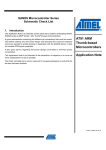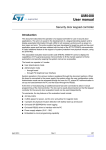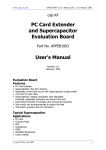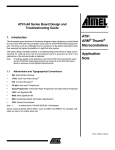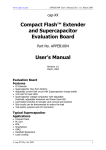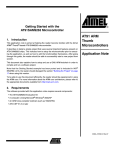Download AT91SAM-ICE User Guide
Transcript
AT91SAM-ICE .............................................................................................. User Guide Table of Contents Section 1 Introduction ........................................................................................... 1-1 1.1 1.2 Overview ...................................................................................................1-1 Requirements............................................................................................1-2 Section 2 Hardware .............................................................................................. 2-1 2.1 2.2 JTAG Connector .......................................................................................2-1 Debugging Multiple ARM® Cores with SAM-ICE ......................................2-2 Section 3 Setup .................................................................................................... 3-1 3.1 3.2 3.3 3.4 Installing the USB Driver ...........................................................................3-1 Debug Installation .....................................................................................3-5 Connecting the Target System .................................................................3-5 Problems ...................................................................................................3-5 Section 4 SAM-ICE Related Software .................................................................. 4-1 4.1 4.2 Overview ...................................................................................................4-1 Free Software ...........................................................................................4-1 Section 5 Frequently Asked Questions................................................................. 5-1 5.1 FAQs .........................................................................................................5-1 Section 6 Support ................................................................................................. 6-1 6.1 6.2 Troubleshooting ........................................................................................6-1 Contacting Support ...................................................................................6-2 Section 7 Glossary................................................................................................ 7-1 7.1 Terminology ..............................................................................................7-1 Section 8 Errata .................................................................................................... 8-1 8.1 AT91SAM-ICE User Guide Reset Problem on the SAM-ICE V5.1 .......................................................8-1 i 6206A–ATARM–24-Nov-05 ii 6206A–ATARM–24-Nov-05 AT91SAM-ICE User Guide Section 1 Introduction SAM-ICE is a JTAG emulator designed for Atmel® AT91 ARM® cores. It connects via USB to a PC running Microsoft Windows2000 or XP. SAM-ICE has a built-in 20-pin JTAG connector, which is compatible with the standard 20-pin connector defined by ARM®. 1.1 Overview 1.1.1 Features of SAM-ICE ! Any Atmel AT91 ARM7™/ARM9™ core supported, including Thumb® mode ! Seamless integration into the IAR® Workbench ! No power supply required, powered through USB ! Maximum JTAG speed 8 MHz ! Auto speed recognition ! All JTAG signals can be monitored ! Support for multiple devices ! Fully plug and play compatible ! Standard 20-pin JTAG connector ! Wide target voltage range: 1.2V to 3.3V ! USB and 20-pin ribbon cable included ! Real-time memory viewer (J-Mem) included ! SAM-ICE TCP/IP server included, can use SAM-ICE via TCP/IP networks ! RDI server available, can use SAM-ICE with RDI compliant software 1.1.2 Specification Table 1-1. SAM-ICE Specification Parameter AT91SAM-ICE User Guide Power Supply USB powered < 50mA USB Interface USB 2.0, full speed Target Interface JTAG 20-pin Serial Transfer Rate between SAM-ICE and Target Up to 8 MHz Supported Target Voltage 1.2V to 3.3V 1-1 6206A–ATARM–24-Nov-05 Introduction Table 1-1. SAM-ICE Specification Parameter Operating Temperature +5°C to +60°C Storage Temperature -20°C to +65 °C Relative Humidity (non-condensing) < 90% rH Size (without cables) 100 mm x 53 mm x 27 mm Weight (without cables) 70 g Electromagnetic Compatibility (EMC) EN 55022, EN 55024 Supported OS Microsoft Windows2000/XP 1.2 Requirements 1.2.1 Host System In order to use SAM-ICE, a host system running Windows2000 or WindowsXP with the SAM-ICE custom USB driver is required. 1.2.2 Target System An Atmel AT91 ARM7 or ARM9 target system is required. The system should have a 20-pin connector as defined by ARM Ltd. The individual pins are described in “JTAG Connector” on page 10. 1-2 6206A–ATARM–24-Nov-05 AT91SAM-ICE User Guide Section 2 Hardware 2.1 JTAG Connector A SAM-ICE connector is a 20-way Insulation Displacement Connector (IDC) keyed box header (2.54 mm male) that mates with IDC sockets mounted on a ribbon cable. 2.1.1 Pinout Table 2-1 lists the SAM-ICE JTAG pinout. Table 2-1. Pinout Pin Signal Type Description 1 VTref Input This is the target reference voltage. It is used to check if the target has power, to create the logic-level reference for the input comparators and controls the output logic levels to the target. It is normally fed from Vdd on the target board and must not have a series resistor. 2 Vsupply NC 3 nTRST Output 4 GND - 5 TDI Output 6 GND - 7 TMS Output 8 GND - 9 TCK Output 10 GND - 11 RTCK NC AT91SAM-ICE User Guide This pin is not connected in SAM-ICE. It is reserved for compatibility with other equipment. Connect to Vdd or leave open in target system. JTAG Reset. Output from SAM-ICE to the Reset signal on the target JTAG port. Typically connected to nTRST on the target CPU. This pin is normally pulled HIGH on the target to avoid unintentional resets when there is no connection. Common ground JTAG data input of target CPU. It is recommended that this pin is pulled to a defined state on the target board. Typically connected to TDI on target CPU. Common ground JTAG mode set input of target CPU. This pin should be pulled up on the target. Typically connected to TMS on target CPU. Common ground JTAG clock signal to target CPU. It is recommended that this pin is pulled to a defined state on the target board. Typically connected to TCK on target CPU. Common ground This pin is not connected in SAM-ICE. It is reserved for compatibility with other equipment to be used as return test clock signal from target JTAG port. Connect to RTCK if available, otherwise to GND. 2-1 6206A–ATARM–24-Nov-05 Hardware Table 2-1. Pinout Pin Signal Type 12 GND - 13 TDO Input 14 GND - 15 RESET I/O 16 GND - 17 - NC 18 GND - 19 - NC 20 GND - 2.2 Debugging Multiple ARM® Cores with SAM-ICE Description Common ground JTAG data output from target CPU. Typically connected to TDO on target CPU. Common ground Target CPU reset signal Common ground This pin is not connected in SAM-ICE. Common ground This pin is not connected in SAM-ICE. Common ground SAM-ICE can handle mulitcore debugging. In this case, multiple ARM chips are connected to the same JTAG connector as shown in Figure 2-1. Figure 2-1. Multi-core Connections TDI TDO Device 0 TCK TDI TMS TDI TDO Device 1 TRST TDO JTAG 2-2 6206A–ATARM–24-Nov-05 AT91SAM-ICE User Guide Section 3 Setup 3.1 Installing the USB Driver When your SAM-ICE is plugged into the computer's USB port, or when the computer is first powered-on after connecting SAM-ICE, Windows® detects the new hardware. The wizard starts the installation of the driver. First, select the "Search for a suitable driver for my device (recommended)" option, then click on the "Next >" button. AT91SAM-ICE User Guide 3-1 6206A–ATARM–24-Nov-05 Setup In the next step, you need to select the "Specify a location" option, and click on the "Next >" button. Copy the driver available on the DVD-ROM to your location. The wizard asks you to specify the location of the correct driver files for the new device. Use the directory navigator to select “D:\tools\driver\usb\jlinkarm” (or your chosen location) and confirm with a click on the "Next >" button. 3-2 6206A–ATARM–24-Nov-05 AT91SAM-ICE User Guide Setup The wizard confirms your choice and starts to copy, when you click on the "OK" button. At this point, the installation is complete. Click on the "Finish" button to dismiss the installation. 3.1.1 Verifying Correct Driver Installation AT91SAM-ICE User Guide To verify the correct installation of the driver, disconnect and reconnect SAM-ICE to the USB port. During the enumeration process which takes about 2 seconds, the LED on SAM-ICE is flashing. After successful enumeration, the LED stays on permanently. 3-3 6206A–ATARM–24-Nov-05 Setup Start the provided sample application JLink.exe. JLink.exe should display the build date of the SAM-ICE firmware, the serial number, a target voltage of 0.000V if a target is not connected to SAM-ICE and the speed selection. See the screenshot below. In addition to this you may verify the driver installation by consulting the Windows® device manager. If the driver is installed and your SAM-ICE is connected to your computer, the device manager should list the J-Link driver as a node below "Universal Serial Bus controllers" as shown in the following screenshot: A right-click on the driver opens a context menu which contains the item “Properties”. If you select this item, a new dialog is opened and should report: “This device is working properly”. 3-4 6206A–ATARM–24-Nov-05 AT91SAM-ICE User Guide Setup 3.2 Debug Installation The SAM-ICE RDI software is an RDI interface for SAM-ICE. It makes it possible to use SAM-ICE with any RDI compliant debugger. The main part of the software is an RDI compliant DLL, which needs to be selected in the debugger. Supported configurations are described on the AT91 DVD-ROM. For additional information on debug, refer to the SAM-ICE "Getting started" bar menu. 3.3 Connecting the Target System 3.3.1 Power-on Sequence SAM-ICE must be powered on before connecting it to the target device. First, connect SAM-ICE to the host system via the USB and then connect SAM-ICE to the target device via JTAG. Power-on the device after you have connected SAM-ICE to it. 3.3.2 Verifying Target Device Connection If the USB driver is working properly and your SAM-ICE is connected to the host system, you may connect SAM-ICE to your target hardware. Then start JLink.exe again; it should now display the same SAM-ICE related information as above. In addition, it should report that it found a JTAG target and the target core ID. The screenshot below shows the output of JLink.exe. As can be seen, it reports a SAM-ICE with one JTAG device connected. 3.4 Problems For help with any of the steps described above, refer to Section 6.1 for troubleshooting tips. AT91SAM-ICE User Guide 3-5 6206A–ATARM–24-Nov-05 Setup 3-6 6206A–ATARM–24-Nov-05 AT91SAM-ICE User Guide Section 4 SAM-ICE Related Software 4.1 Overview Table 4-1. Available Software Packages 4.2 Free Software Software Description JLink.exe Free Command line tool with basic functionality for target analysis. SAM-ICE TCP/IP Server Free utility which provides the possibility to use SAM-ICE remotely via TCP/IP. J-Mem memory viewer Free target memory viewer. Shows the memory content of a running target and allows editing as well. SAM-ICE ARM® Flash DLL An enhanced version of the JLinkARM.DLL, which contains additional API functions for Flash programming. RDI support Provides Remote Debug Interface (RDI) support. Free software related to SAM-ICE ships with SAM-ICE and may also be downloaded from the web site: http://www.segger.com No additional license is required to use this software. 4.2.1 JLink.exe (Command Line Tool) JLink.exe is a tool, that can be used to verify proper installation of the USB driver and to verify the connection to the ARM® chip, as well as for simple analysis of the target system. It permits some simple commands, such as memory dump, halt, step, go and IDcheck, as well as some more in-depths analysis of the the state of the ARM® core and the ICE breaker module. 4.2.2 SAM-ICE TCP/IP Server (Remote SAM-ICE Use) The SAM-ICE TCP/IP server allows using SAM-ICE remotely via TCP/IP. This enables you to connect to and fully use a SAM-ICE from another computer. Performance is just slightly (about 10%) lower than with direct USB connection. AT91SAM-ICE User Guide 4-1 6206A–ATARM–24-Nov-05 SAM-ICE Related Software 4.2.3 J-Mem Memory Viewer 4-2 6206A–ATARM–24-Nov-05 J-Mem displays memory contents of ARM® systems and allows modifications of RAM and SFRs (Special function registers) while the target is running. This makes it possible to look into the memory of an ARM® chip at run time; RAM can be modified and SFRs can be written. The type of acces for both read and write access can be selected to be 8/16/32 bits. This is an efficient means for modifying SFRs, in particular because it writes the SFR only after the complete value has been entered. AT91SAM-ICE User Guide Section 5 Frequently Asked Questions 5.1 FAQs ! Which CPUs are supported? – SAM-ICE works exclusively microcontroller cores. with Atmel AT91 ARM7™/ARM9™-based ! What is the maximum JTAG speed supported by SAM-ICE? – The maximum supported JTAG speed is 8 MHz. ! Can I access individual ICE registers via SAM-ICE? – Yes, you can access all individual ICE registers via SAM-ICE. ! Can SAM-ICE read back the status of the JTAG pins? – Yes, the status of all pins can be read. This includes the outputs of SAM-ICE as well as the supply voltage and can be useful to detect hardware problems on the target system. ! Does SAM-ICE support the embedded trace macro (ETM)? – No. ETM requires another connection to the ARM® chip and a CPU with builtin ETM. AT91SAM-ICE User Guide 5-1 6206A–ATARM–24-Nov-05 Frequently Asked Questions 5-2 6206A–ATARM–24-Nov-05 AT91SAM-ICE User Guide Section 6 Support 6.1 Troubleshooting 6.1.1 General Procedure If you experience problems with a SAM-ICE, follow the steps below to solve these problems: 1. Close all running applications on your host system. 2. Disconnect the SAM-ICE device from USB. 3. Power-off target. 4. Re-connect SAM-ICE to host system (attach USB cable). 5. Power-on target. 6. Try your target application again. It the problem disappears, you are done; otherwise continue. 7. Close all applications running on your host system again. 8. Disconnect the SAM-ICE device from USB. 9. Power-off target. 10. Re-connect SAM-ICE to host system (attach USB cable). 11. Power-on target. 12. Start JLink.exe. 13. If JLink.exe reports the SAM-ICE serial number and the target processor’s core ID, the SAM-ICE is working properly and cannot be the cause of your problem. 14. If JLink.exe is unable to read the target processor’s core ID, you should analyze the communication between your target and SAM-ICE with a logic analyzer or oscilloscope. 15. If your problem persists and you own an original SAM-ICE (not an OEM version), see Section 6.2. 6.1.2 Typical Problem Scenarios 6.1.2.1 SAM-ICE LED is off ! Meaning: – The USB connection does not work. ! Corrective action: AT91SAM-ICE User Guide 6-1 6206A–ATARM–24-Nov-05 Support – Check the USB connection. Try to re-initialize SAM-ICE by disconnecting and reconnecting it. Make sure that the connectors are firmly attached. Check the cable connections on your SAM-ICE and the computer. If this does not solve the problem, please check if your cable is defective. If the USB cable is ok, try a different PC. 6.1.2.2 SAM-ICE LED is flashing at a high frequency ! Meaning: – SAM-ICE cannot be enumerated by the USB controller. ! Most likely causes: – a.) Another program is already using SAM-ICE. – b.) The SAM-ICE USB driver does not work correctly. ! Corrective action: – a.) Close all running applications and try to reinitialize SAM-ICE by disconnecting and reconnecting it. – b.) If the LED blinks permanently, check the correct installation of the SAMICE USB driver. Deinstall and reinstall the driver as shown in Section 3. 6.1.2.3 SAM-ICE does not get any connection to the target ! Most likely causes: – a.) The JTAG cable is defective – b.) The target hardware is defective ! Corrective action: – Follow the steps described in Section 6.1.1. 6.2 Contacting Support Before contacting support, assure that you have tried to solve your problem by following the steps outlined in section Section 6.1.1. You may also try your SAM-ICE with another PC and, if possible, with another target system to see if it works there. If the device functions correctly, the USB setup on the original machine or your target hardware is the source of the problem, not SAM-ICE. Make sure that you have the following information available for the support team: ! A detailed description of the problem ! SAM-ICE serial number ! Output of JLink.exe if available ! Your findings on the signal analysis ! Information about your target hardware (processor, board etc.) 6-2 6206A–ATARM–24-Nov-05 AT91SAM-ICE User Guide Section 7 Glossary 7.1 Terminology Adaptive clocking A technique in which a clock signal is sent out by Multi-ICE and it waits for the returned clock before generating the next clock pulse. The technique allows the Multi-ICE interface unit to adapt to differing signal drive capabilities and differing cable lengths. Application Program Interface A specification of a set of procedures, functions, data structures, and constants that are used to interface two or more software components together. Big-endian Memory organization where the least significant byte of a word is at a higher address than the most significant byte. See Little-endian. Cache cleaning The process of writing dirty data in a cache to main memory. Coprocessor An additional processor that is used for certain operations, for example, for floating-point math calculations, signal processing, or memory management. Dirty data When referring to a processor data cache, data that has been written to the cache but has not been written to main memory. Only write-back caches can have dirty data, because a write-through cache writes data to the cache and to main memory simultaneously. The process of writing dirty data to main memory is called cache cleaning. Dynamic Linked Library (DLL) A collection of programs, any of which can be called when needed by an executing program. A small program that helps a larger program communicate with a device such as a printer or keyboard is often packaged as a DLL. EmbeddedICE™ The additional hardware provided by debuggable ARM® processors to aid debugging. Halfword A 16-bit unit of information. Contents are taken as being an unsigned integer unless otherwise stated. Host A computer which provides data and other services to another computer. Especially, a computer providing debugging services to a target being debugged. ICache Instruction cache. ICE Extension Unit A hardware extension to the EmbeddedICE logic that provides more breakpoint units. ID Identifier. IEEE 1149.1 The IEEE Standard which defines TAP. Commonly (but incorrectly) referred to as JTAG. AT91SAM-ICE User Guide 7-1 6206A–ATARM–24-Nov-05 Glossary Image An executable file that has been loaded onto a processor for execution. In-Circuit Emulator (ICE) A device enabling access to and modification of the signals of a circuit while that circuit is operating. Instruction Register When referring to a TAP controller, a register that controls the operation of the TAP. IR See Instruction Register. Joint Test Action Group (JTAG) The name of the standards group which created the IEEE 1149.1 specification. Little-endian Memory organization where the least significant byte of a word is at a lower address than the most significant byte. See also Big-endian. Memory Management Unit (MMU) Hardware that controls caches and access permissions to blocks of memory, and translates virtual to physical addresses. Multi-ICE® Multi-processor EmbeddedICE interface. ARM® registered trademark. nSRST Abbreviation of System Reset. The electronic signal which causes the target system other than the TAP controller to be reset. This signal is known as nSYSRST in some other manuals. See also nTRST. nTRST Abbreviation of TAP Reset. The electronic signal that causes the target system TAP controller to be reset. This signal is known as nICERST in some other manuals. See also nSRST. Open collector A signal that may be actively driven LOW by one or more drivers, and is otherwise passively pulled HIGH. Also known as a “wired AND” signal. Processor Core The part of a microprocessor that reads instructions from memory and executes them, including the instruction fetch unit, arithmetic and logic unit and the register bank. It excludes optional coprocessors, caches, and the memory management unit. Program Status Register (PSR) Contains some information about the current program and some information about the current processor. Often, therefore, also referred to as Processor Status Register. Is also referred to as Current PSR (CPSR), to emphasize the distinction between it and the Saved PSR (SPSR). The SPSR holds the value the PSR had when the current function was called, and which will be restored when control is returned. Remapping Changing the address of physical memory or devices after the application has started executing. This is typically done to allow RAM to replace ROM once the initialization has been done. Remote Debug Interface (RDI) RDI is an open ARM® standard procedural interface between a debugger and the debug agent. The widest possible adoption of this standard is encouraged. RTCK Returned TCK. The signal which enables Adaptive Clocking. RTOS Real Time Operating System. Scan Chain A group of one or more registers from one or more TAP controllers connected between TDI and TDO, through which test data is shifted. Semihosting A mechanism whereby the target communicates I/O requests made in the application code to the host system, rather than attempting to support the I/O itself. SWI Software Interrupt. An instruction that causes the processor to call a programer-specified subroutine. Used by ARM® to handle semihosting. 7-2 6206A–ATARM–24-Nov-05 AT91SAM-ICE User Guide Glossary TAP Controller Logic on a device which allows access to some or all of that device for test purposes. The circuit functionality is defined in IEEE1149.1. Target The actual processor (real silicon or simulated) on which the application program is running. TCK The electronic clock signal which times data on the TAP data lines TMS, TDI, and TDO. TDI The electronic signal input to a TAP controller from the data source (upstream). Usually this is seen connecting the Multi-ICE Interface Unit to the first TAP controller. TDO The electronic signal output from a TAP controller to the data sink (downstream). Usually this is seen connecting the last TAP controller to the Multi-ICE Interface Unit. Test Access Port (TAP) The port used to access a device's TAP Controller. Comprises TCK, TMS, TDI, TDO and nTRST (optional). Transistor-transistor A type of logic design in which two bipolar transistors drive the logic output to one or Logic (TTL) zero. LSI and VLSI logic often used TTL with HIGH logic level approaching +5V and LOW approaching 0V. Watchpoint A location within the image that will be monitored and that will cause execution to stop when it changes. Word A 32-bit unit of information. Contents are taken as being an unsigned integer unless otherwise stated. AT91SAM-ICE User Guide 7-3 6206A–ATARM–24-Nov-05 Glossary 7-4 6206A–ATARM–24-Nov-05 AT91SAM-ICE User Guide Section 8 Errata 8.1 Reset Problem on the SAM-ICE V5.1 In certain cases, the reset signal generated by the AT91 target may be inoperative due to the fact that the SAM-ICE reset output (JTAG connector pin 15) is a push-pull stage with a 100 Ohm serial resistor. Workaround: Two workarounds are possible: ! Replace R19 by a Schottky diode with the same resistor footprint (e.g. BAT54J). or ! Remove the resistor. This problem has been resolved in SAM-ICE V5.2. R19 AT91SAM-ICE User Guide 8-1 6206A–ATARM–24-Nov-05 Errata 8-2 6206A–ATARM–24-Nov-05 AT91SAM-ICE User Guide Atmel Corporation 2325 Orchard Parkway San Jose, CA 95131, USA Tel: 1(408) 441-0311 Fax: 1(408) 487-2600 Regional Headquarters Europe Atmel Sarl Route des Arsenaux 41 Case Postale 80 CH-1705 Fribourg Switzerland Tel: (41) 26-426-5555 Fax: (41) 26-426-5500 Asia Room 1219 Chinachem Golden Plaza 77 Mody Road Tsimshatsui East Kowloon Hong Kong Tel: (852) 2721-9778 Fax: (852) 2722-1369 Japan 9F, Tonetsu Shinkawa Bldg. 1-24-8 Shinkawa Chuo-ku, Tokyo 104-0033 Japan Tel: (81) 3-3523-3551 Fax: (81) 3-3523-7581 Atmel Operations Memory 2325 Orchard Parkway San Jose, CA 95131, USA Tel: 1(408) 441-0311 Fax: 1(408) 436-4314 RF/Automotive Theresienstrasse 2 Postfach 3535 74025 Heilbronn, Germany Tel: (49) 71-31-67-0 Fax: (49) 71-31-67-2340 Microcontrollers 2325 Orchard Parkway San Jose, CA 95131, USA Tel: 1(408) 441-0311 Fax: 1(408) 436-4314 La Chantrerie BP 70602 44306 Nantes Cedex 3, France Tel: (33) 2-40-18-18-18 Fax: (33) 2-40-18-19-60 ASIC/ASSP/Smart Cards 1150 East Cheyenne Mtn. Blvd. Colorado Springs, CO 80906, USA Tel: 1(719) 576-3300 Fax: 1(719) 540-1759 Biometrics/Imaging/Hi-Rel MPU/ High Speed Converters/RF Datacom Avenue de Rochepleine BP 123 38521 Saint-Egreve Cedex, France Tel: (33) 4-76-58-30-00 Fax: (33) 4-76-58-34-80 Zone Industrielle 13106 Rousset Cedex, France Tel: (33) 4-42-53-60-00 Fax: (33) 4-42-53-60-01 1150 East Cheyenne Mtn. Blvd. Colorado Springs, CO 80906, USA Tel: 1(719) 576-3300 Fax: 1(719) 540-1759 Scottish Enterprise Technology Park Maxwell Building East Kilbride G75 0QR, Scotland Tel: (44) 1355-803-000 Fax: (44) 1355-242-743 Literature Requests www.atmel.com/literature Disclaimer: The information in this document is provided in connection with Atmel products. No license, express or implied, by estoppel or otherwise, to any intellectual property right is granted by this document or in connection with the sale of Atmel products. EXCEPT AS SET FORTH IN ATMEL’S TERMS AND CONDITIONS OF SALE LOCATED ON ATMEL’S WEB SITE, ATMEL ASSUMES NO LIABILITY WHATSOEVER AND DISCLAIMS ANY EXPRESS, IMPLIED OR STATUTORY WARRANTY RELATING TO ITS PRODUCTS INCLUDING, BUT NOT LIMITED TO, THE IMPLIED WARRANTY OF MERCHANTABILITY, FITNESS FOR A PARTICULAR PURPOSE, OR NON-INFRINGEMENT. IN NO EVENT SHALL ATMEL BE LIABLE FOR ANY DIRECT, INDIRECT, CONSEQUENTIAL, PUNITIVE, SPECIAL OR INCIDENTAL DAMAGES (INCLUDING, WITHOUT LIMITATION, DAMAGES FOR LOSS OF PROFITS, BUSINESS INTERRUPTION, OR LOSS OF INFORMATION) ARISING OUT OF THE USE OR INABILITY TO USE THIS DOCUMENT, EVEN IF ATMEL HAS BEEN ADVISED OF THE POSSIBILITY OF SUCH DAMAGES. Atmel makes no representations or warranties with respect to the accuracy or completeness of the contents of this document and reserves the right to make changes to specifications and product descriptions at any time without notice. Atmel does not make any commitment to update the information contained herein. Unless specifically provided otherwise, Atmel products are not suitable for, and shall not be used in, automotive applications. Atmel’s products are not intended, authorized, or warranted for use as components in applications intended to support or sustain life. © Atmel Corporation 2005. All rights reserved. Atmel®, logo and combinations thereof, Everywhere You Are® and others are registered trademarks or trademarks of Atmel Corporation or its subsidiaries. Windows ® and others are the registered trademarks of the Microsoft Corporation. ARM ®, the ARMPowered® logo and others are the registered trademarks, or trademarks of ARM Ltd. Other terms and product names may be trademarks of others. Printed on recycled paper. 6206A–ATARM–24-Nov-05




























